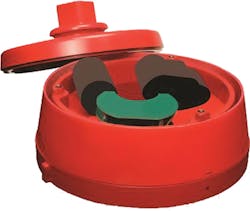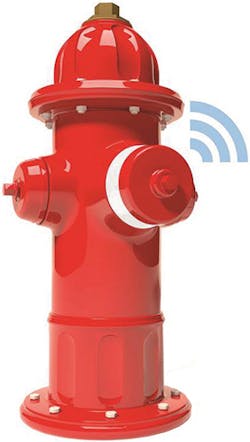Saving Water in Silicon Valley
San Jose Water uses permanent leak detection technology to prevent water loss
By Virgil Diaz
Beginning with just one artesian well that served about 400 San Jose residents in 1866, San Jose Water has grown to serve more than 1 million customers in a 140-square-mile area in Silicon Valley today.
From 2011 to 2017, San Jose, and the state of California at large, experienced one of the worst droughts in its history. The dry conditions reduced many of the state’s reservoirs and resulted in the governor declaring a statewide emergency, calling on residents and utilities to find ways to both cut and conserve water.
“The recent historic drought in California and subsequent calls for customer conservation raised awareness as well as customer expectations for San Jose Water to take proactive steps toward effective and active control of its real-water loss,” said Jake Walsh, director of capital planning and asset management for San Jose Water.
As a result, San Jose Water implemented a pilot water loss control program that would quickly identify, correct and prevent water loss within the distribution network, enabling the utility to promote the long-term sustainability of its limited water resources.
The Search for a Strategic Approach
San Jose’s water distribution network consists of about 2,400 miles of water mains. Prior to deploying its new pilot program, the utility took a traditional approach to leak detection: waiting for leaks in its buried water mains to surface before it would intervene, and conducting an annual proactive inspection program for its above-grade water mains. For its new water loss program, however, San Jose Water was in search of a technology that would allow it to take a more strategic approach to capturing and preventing water loss within its network.
The utility reached out to Echologics® representatives from Mueller Water Products during the initial phase of the pilot and EchoShore®-DX cellular sensors were recommended as the technological solution for the project.
“The EchoShore-DX technology is an acoustic-based system that is utilized through fire hydrant caps,” explained Corey Keefer, Echologics strategic account executive with Mueller Water Products.
The acoustic sensors, embedded into hydrant caps, capture the sound waves traveling through the pipe and use the resulting data file to correlate leak locations.
San Jose Water implemented a pilot water loss control program that would quickly identify, correct and prevent water loss within the distribution network.
The initial results of the technology were positive for the San Jose Water pilot project and provided critical information that was captured upon deployment.
“Prior to investing in acoustic leak detection, we assumed that leaks were typically surfacing within a few days to a week,” said Walsh. “However, we’ve found quite the opposite and determined that some leaks were non-surfacing for more than five years! Within two months of commissioning the units, we found 36 non-surfacing leaks ranging from as small as three gallons per hour to as large as 30 gallons per minute.”
With the ability to detect underground leaks long before they surface, San Jose Water can now focus on regularly assessing the conditions of its water mains. The visualization tools and graphs allow the utility to track points of interest and make determinations regarding field investigations.
“The best part of this is that we can schedule these investigations ahead of time, which allows us to more effectively allocate our limited resources,” Walsh said.
EchoShore®-DX cellular sensors were recommended as the technological solution for the project.
Meeting the Challenge
EchoShore-DX sensors are a critical part of San Jose Water’s leak detection and water loss program, allowing the utility to “stay ahead of existing leaks while monitoring for any potential new ones,” Keefer said.
San Jose Water has been able to see tangible benefits of deploying the technology. In addition to an estimated savings of over 40 million gallons of water to date, there are several events that have demonstrated the technology’s value.
According to Walsh, one such event occurred shortly after deployment, when the sensors identified a leak in the middle of Capital Expressway in San Jose.
“This is a heavily trafficked road and any unplanned emergency repair in this area would disrupt traffic and commutes for thousands of people,” he said. “Additionally, because of its proximity to a creek, any leak on this pipe would have a high consequence of failure because of its potential to discharge chlorinated water into an environmentally sensitive creek.”
The acoustic sensors, embedded into hydrant caps, capture the acoustic sound waves traveling through the pipe and use the resulting data file to correlate leak locations.
Finding this leak prior to its surfacing allowed San Jose Water to send crews to repair it outside of normal commute hours, minimizing disruption and protecting the environment.
San Jose Water will continue to add sensors to its distribution network of about 19,000 hydrants in multiple upcoming phases. For a full system deployment of EchoShore-DX, San Jose Water will need to add about 8,000 more sensors to the 2,000 it has already deployed.
“We plan to continue to strategically deploy acoustic leak detection sensors throughout the service area based on a scientific and objective methodology that focuses our efforts on monitoring pipe segments with the highest probability and consequence of failure,” Walsh said.
The project has been mutually beneficial for Mueller Water Products and San Jose Water. While Walsh noted that the technology has allowed San Jose Water to better serve its customers by improving levels of service, reducing real-water losses and protecting the environment, participation in San Jose Water’s water loss program has also contributed to the development and expansion of the EchoShore-DX technology.
“San Jose has played a critical role in the evolution of this technology,” said Keefer. “A lot of the feedback they’ve provided has helped us develop and integrate analytics and technology enhancements that we are currently using today, which has helped us expand our scalability for other utilities.” WW
About the Author: Virgil Diaz is a senior sales engineer for Mueller Water Products. Learn more at www.muellerwaterproducts.com.
Circle No. 253 on Reader Service Card




